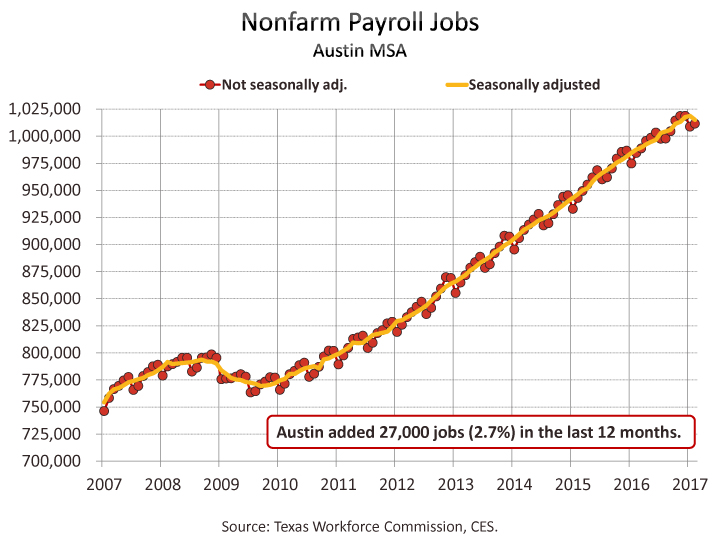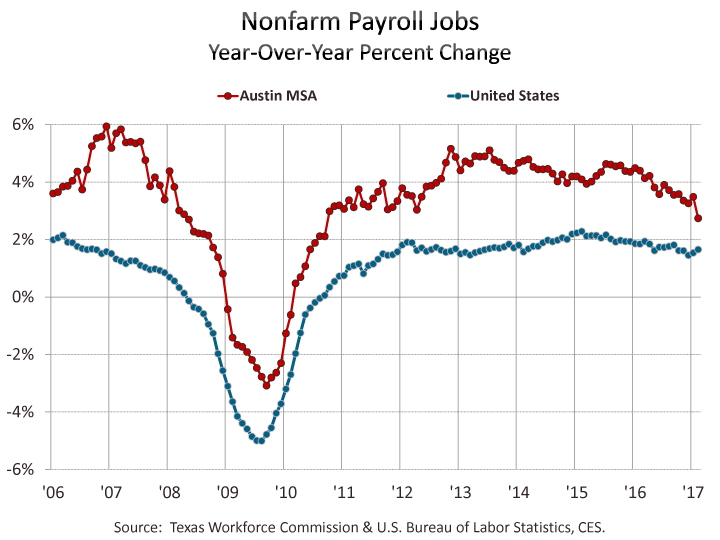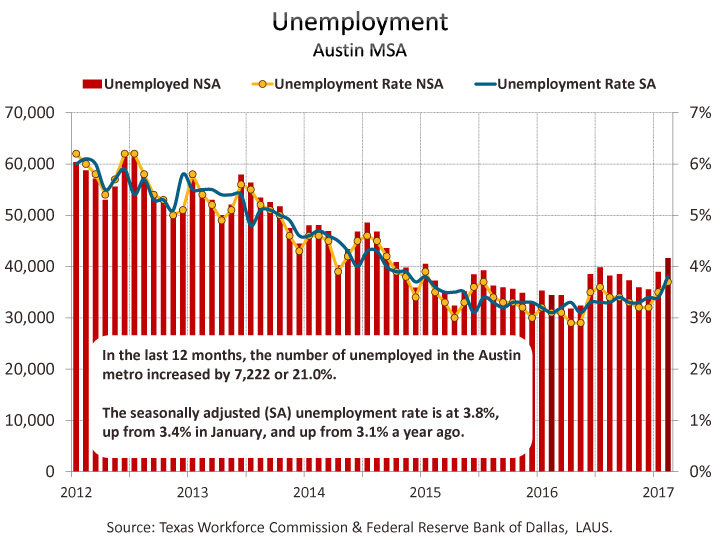Job Growth & Unemployment
Posted on 03/28/2017 by Beverly Kerr
- Austin added 27,000 net new jobs, growth of 2.7%, in the 12 months ending in February, making Austin the 14th fastest growing major metro.
- In Austin, transportation, warehousing and utilities was the fastest growing industry, increasing jobs by 5.8% (1,000 jobs), while leisure and hospitality added the most jobs, 4,800 (4.1%) over the last 12 months.
- Austin's seasonally adjusted unemployment rate is 3.8%, up from 3.4% in January. The rate was 3.1% one year ago.
The Austin metropolitan area added 27,000 net new jobs, or 2.7%, in the 12 months ending in February, according to Friday's releases of preliminary payroll jobs numbers by the Texas Workforce Commission (TWC) and the U.S. Bureau of Labor Statistics (BLS).

Austin’s 2.7% growth makes it the 14th best performing among the 50 largest metro areas. Dallas (3.7%) ranked fourth while the other three major Texas metros also missed the top 10. Fort Worth grew by 2.8% (13th), San Antonio grew by 2.2% (23rd), and Houston grew by 0.6% (47th) between February 2016 and February 2017.

For the year ending in February, private sector job growth in the Austin MSA is 2.8%, or 22,900 jobs, and with all private industry divisions contributing to the growth. Austin's sizable government sector (nearly 18% of jobs) saw slighter growth over the last 12 months, gaining 4,100 jobs or 2.3%, thus bringing the overall job growth rate to 2.7%.

Texas saw net private sector job growth of 1.9% with all private industries, except four, adding jobs over the last 12 months. The government sector, which accounts for over 16% of total state employment, gained less, 1.7%, bringing total job growth statewide to 1.8%. For the nation, private sector growth is 1.8% for the 12 months ending in February with all private industries, but one, adding jobs. Overall job growth is a more modest 1.7% because the government sector gained only 0.9%.

Jobs in February are up from the preceding month by 2,700 jobs or 0.3% in the not-seasonally-adjusted series for Austin, while on a seasonally adjusted basis, jobs are down by 3,600 or 0.4%. Seasonally adjusted jobs are down by 0.2% in Dallas, Fort Worth, and San Antonio, while up by 0.2% in Houston. Statewide, seasonally adjusted jobs are up 6,700 or 0.1% in February. Nationally, seasonally adjusted jobs rose 0.2% in February.

In Austin, the industry adding the most jobs is leisure and hospitality which grew by 4,800 jobs, or 4.1%, over the last 12 months. Transportation, warehousing and utilities grew fastest at 5.8% and added 1,000 jobs. Also growing at faster-than-average rates are construction and natural resources (5.6% or 3,200 jobs), other services (4.8% or 2,000 jobs), and education and health services (3.4% or 3,900 jobs).

Statewide, transportation and warehousing grew fastest (4.6%). The other relatively fast growing industries included education and health services (3.4%), leisure and hospitality (3.3%), other services (3.0%). Jobs declined in information by 2.3%, and by fractions of a percent in wholesale trade, manufacturing, and construction and natural resources over the last 12 months.
Nationally, professional and business services grew fastest, adding 3.0% over the 12 months ending in February. Construction and natural resources, education and health services, and financial activities were also relatively fast growing (by 2.7%, 2.5% and 2.3% respectively). Information jobs fell by 0.3%.

The net gain for private service-providing industries in Austin is 18,700 jobs, or 2.7%, over the last 12 months. Employment in goods producing industries is up by 4,200 jobs or 3.7%. Statewide, private service-providing industries are up 189,300 or 2.3%, but goods producing industries are down 3,900 jobs or -0.2%.
We also now have February labor force, employment, and unemployment numbers for Texas and local areas in Texas. The same data for all U.S. metros that we often do a ranking of will not be released until April 5. In January, Austin had the fifth lowest rate of unemployment among the 50 largest metros.
Unemployment numbers for February show Austin’s performance relative to the state and other major Texas metros being sustained. In February, Austin is at 3.7%, while the other major metros range from 4.2% in San Antonio to 5.9% in Houston. Dallas and Fort Worth are at 4.3% and 4.4% respectively. Austin’s rate one year ago was 3.1%. The rates in Texas’ other major metros are also up from the rates seen a year ago. The statewide not-seasonally-adjusted rate is now 5.1%, up from 4.4% in February of last year. The latest national unemployment rate is 4.9%, compared to 5.2% in February 2016.

Within the Austin MSA, Travis County has the lowest unemployment rate in February, at 3.6%, while Caldwell County has the highest at 4.6%. The rate is 3.7% in Hays County, 3.9% in Williamson County, and 4.1% in Bastrop County.
On a seasonally adjusted basis, Austin’s February unemployment rate is 3.8%, up from 3.4% in January. The last time Austin’s unemployment rate was as high as 3.8% was January 2015. The statewide rate is 4.9%, up from 4.8% in January. Nationally, the seasonally adjusted unemployment rate is 4.7% in February, improved from 4.8% in January.
Among Texas’ major metros, Dallas has the next lowest seasonally adjusted rate at 4.1%, while San Antonio, Fort Worth, and Houston are at 4.2%, 4.5%, and 5.7% respectively. February rates are up from January in each metro. Seasonally adjusted unemployment rates for Texas metros are produced by the Federal Reserve Bank of Dallas. (The TWC also produces seasonally adjusted rates for Texas metros, but publication lags the Dallas Fed’s data.)

With Austin’s unemployment rate up from one year ago, the number unemployed has also increased. In February 2016, Austin’s number of unemployed was 34,437. Over the last 12 months, the unemployed have increased by 7,222 or 21.0%, to 41,659. That’s a number higher than any month of the previous two years.

The Austin metro’s civilian labor force (employed plus unemployed) has increased by 3.0% or 32,482 persons from one year ago, while persons employed increased by 2.4% or 25,260. Texas has also seen greater growth in labor force (2.1%) than employed (1.4%), and the number unemployed increased by 18.4%. Nationally, February civilian labor force is up by 0.8%, while employed is above the level of a year ago by 1.0%, and 160,000 fewer people (1.9%) are unemployed.

Texas Workforce Commission will release February estimates on April 21.
Related Categories: Central Texas Economy in Perspective